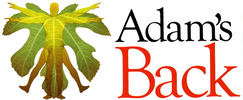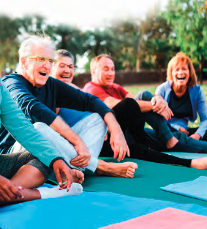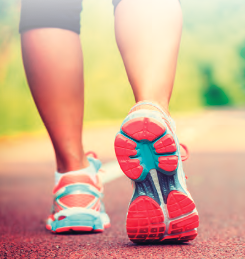A change in season often means a change in diet and routine, like seeking the warmth of the couch and eating more! With these easy tips you can eat for comfort yet still maintain your health.Veggie innovations: swap pasta for zucchini or carrot ‘noodles’. Try cauliflower ‘rice’ instead of white rice.
Protein power: include eggs, lean meat, tofu, or nuts/seeds in every meal to curb cravings. Seasonal selections: opt for root veggies, broccoli, cauliflower, pears, and oranges. Try our recipe for winter fritters! Fibre focus: kick-start your day with oat porridge and kiwifruit. Add legumes to meat and veggie dishes. Healthy fats: use olive oil for dressings and cooking. Try avocado, hummus, or nut butters on bread instead of butter. Raw boost: aid immunity and digestion by adding fresh, raw food to every meal. Warmth factor: use spices with warming properties such as ginger, chilli and paprika. Batch cook: prepare batches of soup or casserole for convenient freezer-friendly meals.
0 Comments
Are you experiencing the challenges of aging? Perhaps you find that movement is becoming difficult, whether it's walking, dressing, lifting items, or simply getting up from a chair. You may often feel stiffness and discomfort in your spine and joints, as if they're encased in concrete, or you may be concerned about dizziness and the risk of falling.Chiropractic care has long been a cornerstone for older people seeking to preserve their mobility, comfort, and overall quality of life. Common reasons for seeking chiropractic care include back issues, neck pain, leg problems, headaches, muscle issues, and osteoarthritis. Stiffness and dizziness are not uncommon issues, either. Chiropractic may help with each of these problems.
Back pain, particularly when chronic (ongoing), can significantly impact your daily life, making routine activities challenging. Things we take for granted, like self-care, movement, and enjoying a social life, can suffer. Chiropractic care − through adjustments, tailored advice on self-management, and appropriate exercises − has been shown to ease both short-term and long-term back pain. Neck pain, a persistent irritation for many, can also cause considerable soreness and disability, with discomfort sometimes becoming long-term. Seeking help as soon as neck pain arises is wise, as prompt treatment may reduce its progression and recurrence. You may have heard of the saying, "when you're young, you fall over. When you're older, you have a fall." Trouble with balance increases with age, and the biggest risk of balance problems is potentially devastating falls. A study published in the Journal of Evidence-Based Integrative Medicine investigated whether chiropractic care could improve balance. The authors found that individuals were “very likely” to report benefit, especially those aged 65 and over. Chiropractic care plays an important role in aging−reducing pain and stiffness, maintaining mobility, and improving balance. It offers a natural, non-invasive approach to promote comfort, ease, and function in later years. Knowing what to expect when you consult with a chiropractor can be complicated. There is no one-size- fits-all solution, but let's look at some similarities in chiropractic treatment to give you a starting point.We each have our own unique approach, techniques, ongoing education, fields of interest, and thought processes. Similarly, each patient has differences in anatomy, response to treatment, lifestyle choices, medical history and health. Also, your expectations, preferences, commitment to healing and personal factors all influence the treatment process and duration.
During your initial consultation,we usually allocate extra time to get to know you better. We will ask you detailed questions about your health history, and conduct tests to evaluate how your body functions, especially focusing on your spine health and nervous system.If it is necessary, we may also recommend scans. This process helps us put together all the pieces of your health puzzle to understand how we can best assist you. You may or may not receive a chiropractic adjustment on your first visit. During your routine appointments, we require less time because we're already familiar with your treatment plan. We've determined the most suitable schedule and type of care for you. Now, our focus is on enhancing the health of your spine and overall well-being. During these visits, we'll examine your spine and other relevant areas, using our hands and possibly other tools to pinpoint any specific concerns. We ask about your symptoms or progress, and answer any questions you may have. We adjust joints that don’t work properly. Treatment aims to improve and stabilise their mobility and function. The type of adjustment we use is chosen carefully, depending on a range of factors. For example: where you need to be adjusted, your body’s constitution, pain levels, current health conditions, sensitivity, age, and whether or not you are pregnant. We might offer you additional advice and recommendations on nutrition, footwear, optimal positions and postures for activities like work, sitting, lifting, and sleeping. If applicable we will also advise on exercises aimed at enhancing muscle function and joint mobility. Health education, home care strategies, and weight management can contribute significantly to overall wellness. 6/3/2024 0 Comments Peach and ‘cream’ ice blocksThese homemade ice blocks are not only tasty and easy to make, but healthy too.They’re perfect for dessert or a cool treat after school, and will satisfy any sweet cravings!Ingredients
Instructions
By now, most people know the dangers of cigarette smoking. It’s a habit that increases the risk of lung cancer and heart disease, but did you know that it’s also linked to back pain? The connection may seem odd at first, so let’s examine how and why cigarette smoking could be causing or worsening your discomfort.Chronic inflammation
Tobacco smoke contains over 7,000 chemicals. Many of which are known to harm your body in various ways; including some which can affect your back. For example, smoking can worsen chronic inflammation, a prolonged bodily response which is linked to back problems. Chronic inflammation can lead to the breakdown of proteins, essential for muscle strength and endurance, weakening muscles and contributing to pain and discomfort. People with low back pain often have elevated levels of inflammation, making smoking a risk factor for aggravating back issues. Bone weakness Recent evidence demonstrates that tobacco smoking causes lower bone mass, increasing the risk of osteoporosis and fracture. This means even a cough or a minor fall can result in bone fractures, including those in your spine. However, the impact of weakened bones extends beyond fractures; osteoporosis can cause skeletal deformities, joint issues, and increased muscle tension. Severe back pain is a common symptom for people who have this condition. Smoking cigarettes also slows down the healing of fractures. The more you smoke, and the longer you smoke, the worse these effects become, although more studies are needed to find out exactly why. Smoking also leads to more complications during medical treatments, making recovery and hospital stays longer. Blood circulation Smoking cigarettes reduces blood flow to your spine, depriving it of essential nutrients. As a consequence, the discs, the cushioning between your vertebrae, can harden and tear. Joint cartilage deteriorates, reducing shock absorption, and lubrication decreases. The overall result is accelerated wear on bones, discs, and joints, and inadequate healing. This combination can lead to degeneration, damage, dysfunction, and pain. Smoking not only causes physical changes that worsen back pain but also affects mental well- being. Stress, especially, increases the chances of long-term low back pain, and the more stressed you are, the higher the risk. Some people turn to smoking to find relaxation through the nicotine hit. However, once the calming effect fades, stress- like symptoms such as anger, anxiety, frustration, and irritability can emerge. This sets up a harmful cycle of stress, smoking, and pain. However the news is not all bad. Stopping smoking helps to halt, and sometimes even reverse, the damage; allowing your back to heal. This big step will not only improve your overall health, but could also alleviate your back pain. As always, if you have any questions, please ask us. Your nervous system manages everything in your body — actions, thoughts, sensations, and how you interact with the world. It has sympathetic and parasympathetic branches that enable you to respond to threats, or relax and heal.Let's explore this further.
You can think of these branches as the accelerator and brake, working together to keep your body balanced and functioning correctly. The sympathetic nervous system (SNS) is like the accelerator, preparing you to respond to stress or danger — for “fight or flight.” It increases your heart rate and blood pressure, slows digestion, redirects blood flow to the muscles, and triggers the release of glucose for extra energy. The parasympathetic nervous system (PNS) is like the brake, also referred to as the “rest and digest” system. The PNS conserves energy and promotes relaxation and recovery. It reduces heart rate and blood pressure, supports digestion, fertility, and repair. Sometimes, the accelerator ‘sticks’— this happens when the sympathetic system becomes overly active. The nervous system is thrown out of balance and leads to a state known as sympathetic dominance. The causes vary, but it’s often triggered by the stressors of modern life, such as being constantly busy, overwork, financial struggles, mental health challenges, and physical illness. As a result, we become trapped in a survival loop, neglecting relaxation and healing. From a chiropractic perspective, sympathetic dominance may cause issues such as: anxiety, digestive problems, fatigue, headaches, high blood pressure, increased heart rate or palpitations, low mood, physical tension and discomfort, shortness of breath, trouble sleeping. These symptoms can occur with various other health issues, so seeking professional advice is essential. If you do have sympathetic dominance, there are steps you can take to recover. Start by addressing the leading cause: ongoing stress. Find the sources of stress in your life and limit its impact. Here are some practical lifestyle tips to bring back balance in your life: • Practice mind-body techniques: meditation and deep-breathing can promote relaxation. • Find relaxation through hobbies and activities you enjoy. • Prioritise sleep – to be healthy, you must sleep well. • Follow a wholefood, balanced diet. • Limit your caffeine and alcohol intake. • Quit smoking. • Exercise regularly with gentle activities like: walking, yoga, Tai Chi, swimming, light resistance training, and flexibility exercises. Feel free to inquire about sympathetic dominance and discovering the underlying reasons behind your symptoms. 6/3/2024 2 Comments Why do we have food cravings?Our brains are complicated... but our needs are simple. We respond to fatty, sugary, salty foods with immediate, short-term feelings of pleasure, and this can present itself as cravings for unhealthy foods. Unfortunately this can have a serious impact on our health.A food craving usually means a desire for food which is unrelated to any nutritional need or hunger. Food cravings are more tied in with habits, pleasure and emotions, than with nourishment. We don’t crave vitamin tablets... we crave donuts
Several studies in 2022 on mice have produced interesting results. A study from Columbia University discovered that craving fatty food is not just about taste; it appears that the gut can ‘tell’ the brain what the body wants or needs. Another study from the University of Pittsburgh found that microbes in the gut of animals may affect their food choices by making substances that create cravings. These findings suggest that although we can influence our thoughts about food, we have less control over how our gut guides cravings. It’s uncertain how this will help fight obesity, but gaining insights into the reasons behind cravings may lead to advances in weight management and disease prevention. The gut-brain connection is complex and further research is needed. Until we have those answers, there are some practical ways food cravings can be controlled:
Mindfulness – taking the time to consider whether you’re actually hungry, whether it’s a habit (like a cake with coffee), emotional, or other reasons for choosing unhealthy food. Have you ever felt a tight ‘knot’ in your muscle - a spot that feels tender and solid to touch? When pressed, it may cause pain, tingling, or burning in another area. These are called trigger points, myofascial trigger points, or TrPs for short.TrPs are generally defined by some common features: a taut band of muscle, a hypersensitive spot, and referred pain. In other words, that tender point that sits within a firm muscle and when pressed, sends pain or other sensations to other areas in your body. And they can be nasty! But how and why do they happen?
What causes TrPs? Many activities can strain muscle fibres, causing contraction over time, and leading to the development of trigger points. These actions include: • sudden injuries such as falls or sprains • small repetitive movements like typing • long-term high-impact activities like jogging and running • everyday actions like consistently carrying heavy items • poor posture, and staying in the same position for prolonged periods. Where do TrPs commonly occur? TrPs are common and often affect the muscles in your neck, shoulders, upper and lower back, as these areas often bear the impact of repetitive movements and tension. These trigger points are associated with shoulder issues, neck and back pain, as well as headaches, including migraines and tension-type headaches. They can also develop in arthritic knees, and tend to increase after a stroke. Can TrPs be prevented or treated? Yes, absolutely! Trigger points may be treated in a variety of ways: these typically include manual techniques like massage, trigger point compression, and targeted stretching exercises. Relaxation techniques are also used to alleviate symptoms and promote healing. From a chiropractic perspective, minimising or removing the cause or causes is essential. If your posture is poor, we’ll work with you to improve it. If your occupation carries risks, we can advise you on how to lessen them. We may adjust your spine and, if needed, other joints. An improvement in nerve function may help your muscles to relax. "Pull your shoulders back!” “Stand up straight!” You’ve probably heard these words before, but is there any wisdom in them? Or are they from a bygone era fixated on a prim and proper appearance? It’s an important question in today’s world where we spend hours hunched over computers and sitting. |
AuthorAdam's Back is a team of dedicated complimentary health professionals. Our aim is to support you in finding drug-free solutions for better health. Archives
July 2024
Categories |
Search by typing & pressing enter













 RSS Feed
RSS Feed